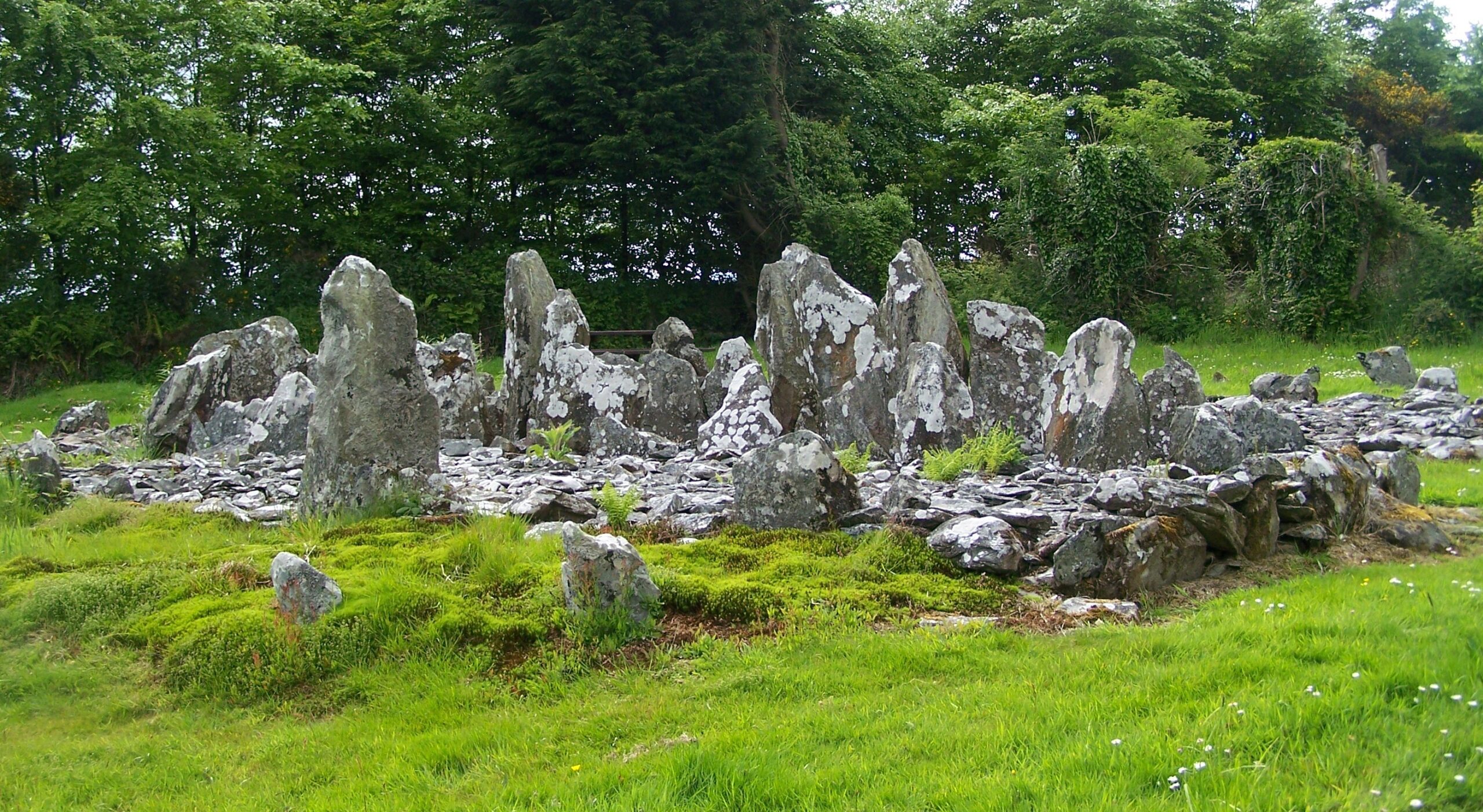Court Cairns
Rearcross is a land of ancient history and along this land people have left their mark for 5000 years. The early settlers belong to the Neolithic period in history. They were farmers who reared cattle, sheep and pigs on the well-drained hills and sloped having cleared the dense forests with stone axes. Some of the earliest evidence of Neolithic farmers in Tipperary come from the Rearcross and Kilcommon areas. The later discovery of rich copper deposits in the hills around Rearcross and Kilcommon and the evidence of copper mining in Lackamore dating to the Bronze Age may also account for the early habitation of the area. The homes of these early settlers were simple but they made striking stone tombs for the dead. The respect which these farmers had for the dead and their belief in an afterlife is shown not only by these imposing tombs but also by their practice of depositing pottery and flint arrow heads with their dead. Because these tombs were made of large stones, they have been called megalithic from the Greek words mega (great) and lithos (stone).
These graves are the most spectacular legacy of Irish prehistoric man and some of the very best  examples of these early tombs are to be found in the Rearcross area. For many years these striking tombs have been seen as objects of mystery and were explained as “Giant Graves” “Druid Altars” and “Diarmuid and Grainne beds”. Gaelic words such as comeach and gallan have been used to refer to them. Today farmers fearing the good people have been inclined to leave them undisturbed. Over twenty tombs are to be found in the area with some of the best located in Shanballyedmond, Barnadomeeney and Bouraglanna, all near Rearcross village. The Shanballyedmond tomb is referred as a “Court Cairn” and is one of the oldest in the area. It is special because most tombs of this type are found in the northern part of the country. This “Court Cairn” was excavated in 1958 by Professor O’Kelly of UCC and was found to contain six cremated burials. Twelve wedged tombs getting their name from their distinctive wedge shape are found in Rearcross, Kilcommon and the surrounding area and are scattered around Moherclay at altitudes ranging seven hundred feet to one thousand feet with the best examples at Barnadomeeney. Here the cremated remains of twenty one people were identified. Pottery, flint and arrow heads were also discovered. Cyst burial tombs which consisted of a stone lined grave set-in a round mould are widespread in the area with good examples to be found in Reardnoggymore and at the summit of Moherclay.
examples of these early tombs are to be found in the Rearcross area. For many years these striking tombs have been seen as objects of mystery and were explained as “Giant Graves” “Druid Altars” and “Diarmuid and Grainne beds”. Gaelic words such as comeach and gallan have been used to refer to them. Today farmers fearing the good people have been inclined to leave them undisturbed. Over twenty tombs are to be found in the area with some of the best located in Shanballyedmond, Barnadomeeney and Bouraglanna, all near Rearcross village. The Shanballyedmond tomb is referred as a “Court Cairn” and is one of the oldest in the area. It is special because most tombs of this type are found in the northern part of the country. This “Court Cairn” was excavated in 1958 by Professor O’Kelly of UCC and was found to contain six cremated burials. Twelve wedged tombs getting their name from their distinctive wedge shape are found in Rearcross, Kilcommon and the surrounding area and are scattered around Moherclay at altitudes ranging seven hundred feet to one thousand feet with the best examples at Barnadomeeney. Here the cremated remains of twenty one people were identified. Pottery, flint and arrow heads were also discovered. Cyst burial tombs which consisted of a stone lined grave set-in a round mould are widespread in the area with good examples to be found in Reardnoggymore and at the summit of Moherclay.
Stone circles enclosing an open space found in Bouraglanna near Barnadomeeney. They are probably connected with religious ceremonies such as the worship of the sun and may or may not have been used as burial grounds. Another which is widely distributed throughout the Rearcross & Kilcommon area is the standing stone. One such stone can be found at Longstone, and these refer to stones which have been stood on end and can vary in height from three feet to twenty feet tall. Two good examples are found in Barnadomeeney and Curreeney Commons. Some may have served as markers or ancient boundaries or the routes of roadways while it is also believed they have also been used to record notable events. The early farmers who settled in the Rearcross and Kilcommon areas came in search of pastures for their livestock and arable land on which to grow crops. The later discovery of copper in the area attracted further settlement. The major part of information about these people come not from their homes which rarely survived but rather from their burial sites. Our local area provides us with some of the earliest and best evidence not only in Tipperary but in Ireland as a whole for the study of our prehistoric ancestors.
Written by James T. Nolan (July 2016)